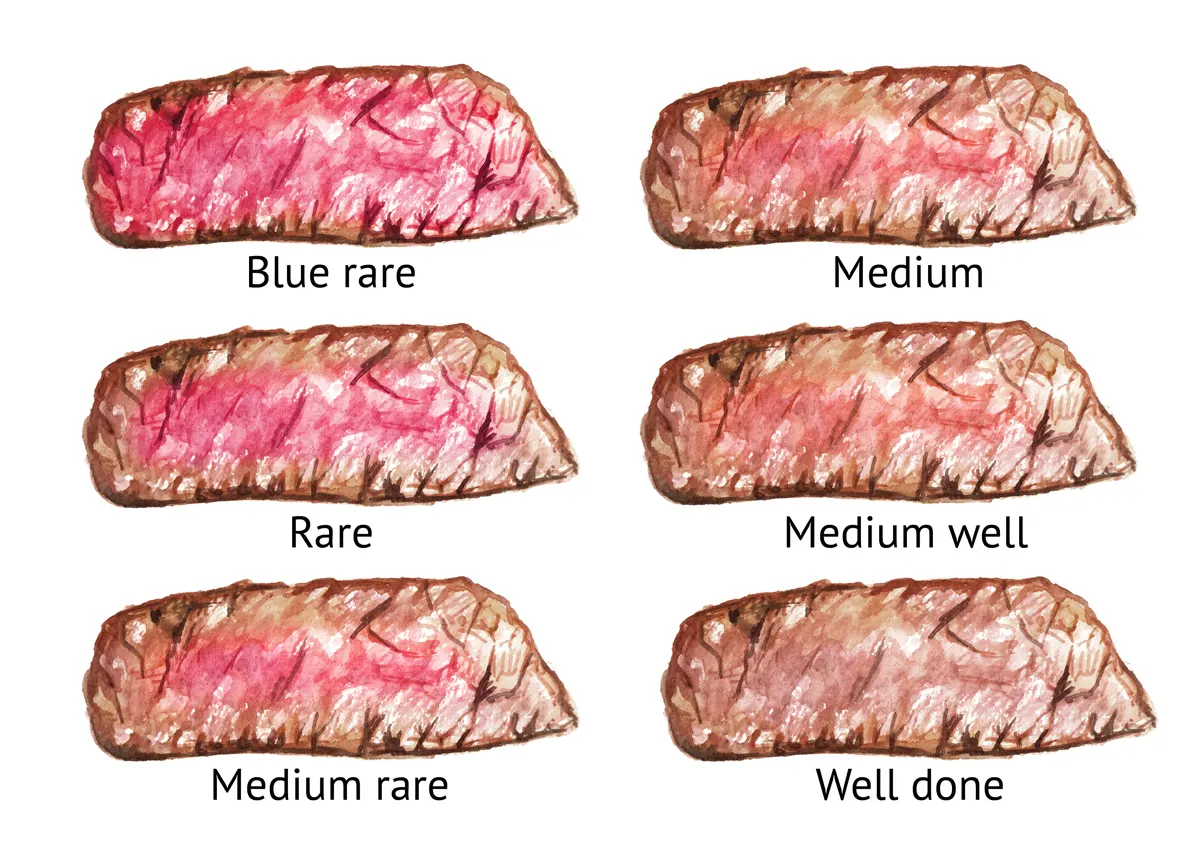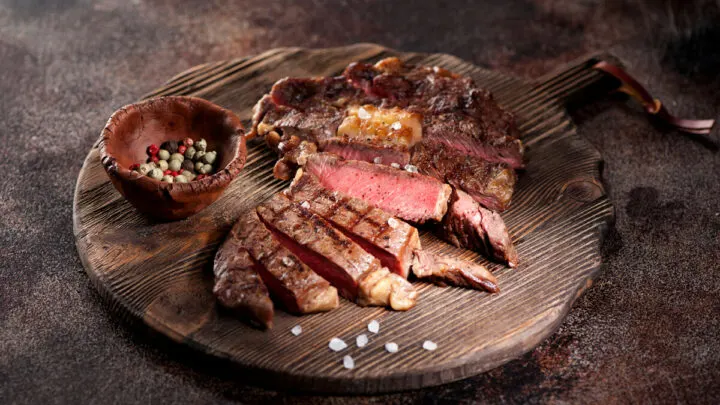Grilling steak seems as simple as tossing it on a natural gas grill or cast-iron skillet. However, you need quite a bit of skill if you attempt to cook a steak.
Cooking the perfect steak can seem like an uphill battle, especially when it comes to the level of doneness.
Everyone will try to tell you what they think is the best. The most popular temperatures for steak are rare and medium-rare.
As you can imagine, both rare and medium-rare purists are at each other’s throats, screaming that their desired temperature is best. This has launched a full-scale debate about which temperature is superior.
However, to fully understand the rare vs. medium-rare debate, we must discuss safety first.
Contents
Is Rare Steak Safe To Eat?
Technically speaking, rare steak is not safe to eat. The USDA discourages eating raw or undercooked meat, which includes beef.
Meat can have harmful bacteria. Bacteria can lead to food poisoning, which means you may experience symptoms such as abdominal pain, headaches, nausea, fever, chills, and vomiting.
Furthermore, if you fed raw or undercooked meat to another person, you could be remembered as the person who gave everyone tainted food.
Although rare meat is cooked, it may not be cooked to a temperature high enough to neutralize the beef’s bacteria. Remember, only the outside of the meat will touch the heat. So the interior could still contain bacteria.
You should cook your steak to a minimum of 145°F, the recommended safe temperature for steak.
Nevertheless, you can still eat rare steak but do so with extreme caution. If you’re eating out, make sure you order your rare steak from a reputable steak house that serves high-quality food.
This way, you can be sure that the cooks who prepare your steak are knowledgeable about different cuts of beef. This decreases the risk that you will get sick from eating rare beef.
In contrast, if you choose to purchase a rare steak from the first restaurant, you see, without doing any research, the risk that you will be exposed to bacteria increases. In this instance, it’s best to select another degree of doneness.
On the other hand, if you’re cooking rare steak at home, make sure you purchase the beef from a reputable supplier.
In addition to this, use a trusted, tested recipe for rare steak. Do not attempt to wing it, as it may cause the steak to be cooked inadequately.
Is Medium Rare Steak Safe?
Generally, medium-rare steak is considered safe. It reaches a safe enough temperature to neutralize bacteria.
Since it is cooked to 145°F, medium-rare steak is better for at-risk populations like pregnant women, the elderly, or patients with AIDS/HIV. These persons have compromised immune systems, which may be unable to fight off a bacterial infection caused by eating rare steak.

Rare vs. Medium Rare
When it comes to steak, there will always be a debate, degree of doneness included. To understand the differences between each temperature, we must compare and contrast each temperature.
Temperature
Both degrees of doneness have different temperatures. Rare steaks have a temperature between 125°-130°F. Medium-rare steaks have a temperature between 130°-140°F.
Remember, a steak’s temperature will keep on rising even though you have removed it from the heat. Therefore, pull the steaks off the grill a few degrees before reaching your desired temperature.
Cooking Time
The cooking time of steak depends on how it is cooked as well as the type of steak you are cooking. In general, it will take about 6-8 minutes to grill a rare steak. In contrast, it will take about 8-10 minutes to cook a medium-rare steak.
A rare steak takes about 5 minutes to sear in a cast iron skillet and 7 minutes to cook a medium-rare steak in a skillet.
The type of steak also determines the cooking time. Some steaks are thinner, like the eye of round steak, while others are thicker, like ribeye steak.
For example, it takes 4 minutes to cook a rare ribeye steak and 5-6 minutes to cook a medium-rare ribeye steak.
Texture And Flavor
The texture and flavor of steak depend on how it’s cooked as well as the cut of beef. Medium-rare has a juicy, robust flavor and a firm yet tender texture. In contrast, rare steak also has a juicy texture.
However, it is juicier than medium-rare steak since it spends less time on the stove or grill. In addition to this, rare steak also has a softer, more tender texture.
Rare steak is often described as having a bloody taste. While the bloody taste isn’t exactly displeasing, you are not actually eating blood.
You are eating myoglobin. Myoglobin is the pigment that gives the steak its rich reddish, pinkish color.
If the cow is harvested correctly, the steaks should not contain any blood. Therefore, you are not actually eating blood. You are eating the meat’s juices.
Color
Next to the temperature, the color is the easiest way to determine if the steak is rare or medium-rare.
Since both steaks are seared on the outside, the only way to reveal the degree of doneness is to cut them open.
Since rare steaks are gently cooked on the outside to lock in the beef’s juices, it is 70% percent red. There will be a faint line of brown surrounding a red center.
Medium-rare steaks are seared on the outside. However, the center of the steak contains a beautiful pink band in the center of the meat.
Touch
Rare and medium-rare steaks feel different. Medium-rare is said to feel like a cheek. They are soft but still firm.
Alternatively, medium rare steaks can also feel like a specific spot on your hand. A medium-rare steak feels like the area just below the base of the thumb.
In contrast, rare steaks are soft. They feel like the area between your thumb and forefinger.
Additionally, medium-rare steaks feel warm in the center since they are cooked longer. Rare steaks are cool in the center since they are cooked for a shorter time.
Which Is Better Rare or Medium Rare
Which steak temperature is best depends on your preference. If you prefer a more tender steak with a softer texture, a rare steak may be better.
In contrast, if you prefer a more done steak that is tender yet firm, it’s best to go with a medium-rare steak.
In addition to this, if food safety is a huge concern, it may be best t go with a medium-rare steak. Remember, rare steaks are not cooked to the recommended internal temperature of 145°F
How To Cook Rare Steak
A rare steak needs to have a seared exterior and cool red center. This method works best with 1-inch steaks such as Tomahawk or Porterhouse steaks.
To grill your rare steak, set your grill to medium-rare and season your steak. It may be best to season it with good old salt and pepper, based on the kind of steak you are grilling.
You can salt the steak up to 24 hours in advance. The salt will pull moisture out of the steak.
The mixture will then be reabsorbed by the steak and create a perfectly seared steak. If you are going to salt the steak in advance, do not season it with pepper.
Season the steaks with pepper right before you place them on the grill.
Place your steaks onto the grill and cook them for 4-5 minutes. Turn the steaks over and cook them for an additional 3 minutes. The steak’s internal temperature should be between 130°-140°F.
Remove the steaks from the grill and place them onto a plate. Tint them with foil and let them rest for 5 minutes before serving them.
How To Cook Medium Rare Steak
Medium rare steaks should be browned on the inside with a warm pink center. The steak should also have a firm texture that springs back like a cake. Again, this method only applies to 1-inch steaks.
To cook a medium-rare steak, set up your kamado grill and let it preheat to medium-high heat. Once the grill comes up to the right temperature, add your steaks, and cook them for 5 minutes.
Turn the steaks over. and cook them for an additional 4 minutes until they have an internal temperature of 130°-140°F.
Remove your steaks from the grill and set them on a plate. Loosely cover the steaks with foil to keep them warm, and let them rest for 5 minutes before serving them.
Final Thoughts
Some people think the rare vs. medium-rare debate is unnecessary. After all, it’s just a steak temperature, right?
However, it’s not just a steak temperature. Medium-rare steak is different from rare steak. Both steak temperatures are delicious, but they also yield very different results.
S when it comes to the winner, there is no winner. The temperature your steak should be cooked depends on your preference. You are the one consuming the steak, so you get to decide!
You might also be interested in the following:

I have been smoking and grilling meat from an early age and enjoy sharing my knowledge and expertise through the hundreds of articles I have written about BBQ. I hope to make everyone’s BBQ journey that little bit easier.

